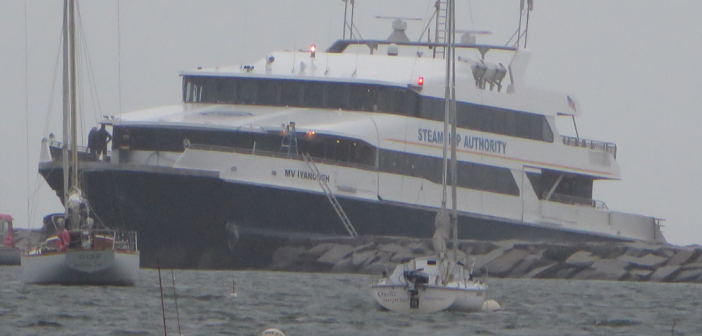At 9:33 on a rainy night in June two years ago, the 154-foot-long Iyanough fast ferry from Nantucket ran headlong into the breakwater in Hyannisport, Massachusetts, at 30 knots, even though there were two officers with decades of experience on the bridge. In the crash, 15 people were injured, and a Coast Guard helicopter lifted them to shore. The other 42 people on board climbed down a ladder to the breakwater; the last one reached land at 3:30 a.m.
How did the captain, Karl Riddar, and the pilot, Thomas Manley, miss the turn into Hyannis Harbor and the ferry terminal and crash into the breakwater? The Coast Guard just released hundreds of documents after its investigation into the accident.
The short answer: Looking at the radar, Riddar thought he saw the familiar pattern of three upcoming buoys in the harbor. What he really saw was the light at the end of the breakwater and two masthead lights from moored sailboats in the distance. But it’s more complicated than that.
The Steamship Authority, which runs the ferries from Nantucket and Martha’s Vineyard to Cape Cod, was short of experienced captains and pilots that night. It called Manley out of retirement to work on the Iyanough; he had not worked for ten months. Usually, the captain is in charge of the ferry on the trip to Nantucket, and the pilot does the return. But this night, because of Manley’s time out, Riddar took over on both trips. The weather was a factor, with 30-knot winds, 6 to 8 foot seas, and periods of rain.
At 9:33, according to the Coast Guard report, the ferry passed the “HH” buoy marking the entrance to Hyannis Harbor. Because of the weather, Riddar told Manley to turn on the ferry’s spotlight. Manley was not familiar with it, and it took him 15 seconds, with Riddar’s help, to turn it on. Then Riddar turned to the radar.
The report said that Riddar “did not see the need to slow down as he thought he was in the correct position and he had completed this journey thousands of times, and if he did slow down, due to the wind and waves, the journey would be really bad.”
But it concluded that “The weather, coupled with a pilot who was not familiar with the bridge controls (specifically the operation of the spotlight), the fact that the number “4” entrance buoy into Hyannis Harbor was never visually acquired by either the master or the pilot, and that this was the Iyanough’s last run of the day, should have given the master sufficient reason to operate at slower speed.: Read more:




